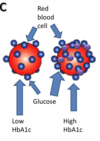What is Diabetes Mellitus? (including Epidemiology of Diabetes) Flashcards
What is diabetes mellitus?
- A group of metabolic diseases of multiple aetiologies characterised by hyperglycaemia, together with disturbance of carbohydrate, fat and protein metabolism resulting from defects in insulin secretion, insulin action or both
In diabetes mellitus, what are the symptoms of hyperglycaemia?
- Polydipsia (excessive thirst)
- Polyuria (excessive urine production)
- Blurred vision
- Infections
- Weight loss
In diabetes mellitus, what are the complications of hyperglycaemia?
- Diabetic ketoacidosis (DKA)
Microvascular long-term complications:
- Neuropathy
- Retinopathy
- Nephropathy
Macrovascular long-term complications:
- Stroke (cerebral artery)
- MI (coronary artery)
- Peripheral vascular disease
How do we diagnose diabetes?
To make a diagnosis of diabetes:
- 1 diagnostic lab glucose + symptoms
OR
- 2 diagnostic lab glucose or HbA1c levels without symptoms
Diagnosing diabetes:
- Check glucose levels (venous plasma). Fasting glucose ≥7.0 mmol/L or random glucose ≥11.1 mmol/L
- Oral glucose tolerance test: Fast overnight, measure venous plasma blood glucose, give 75g of glucose in water and measure venous plasma glucose levels 2 hours after the drink. Look for glucose levels ≥11.1 mmol/L
- Diagnostic HbA1c ≥48 mmol/mol
(Diabetes diagnostic criteria identify a group with significantly increased premature mortality and increased risk of microvascular and cardiovascular complications)

What is HbA1c and why is it used as part of the diagnosis in diabetes?
- Glycated haemoglobin
- Glucose in the blood binds irreversibly to a specific part of haemoglobin in red blood cells, forming HbA1c
The higher the glucose, the higher the HbA1c
HbA1c circulates for the lifespan of the red blood cell, so reflects the prevailing blood glucose levels over the preceding 2-3 months

Glucose levels vs HbA1c advantages and disadvantages (LATER)
LATER
When can HbA1c NOT be used for diagnosis of diabetes?
When HbA1c cannot be used for diagnosis:
- All children and young people
- Pregnancy
- Acutely unwell patients who are at high risk of diabetes
- Patients taking short term medication that may cause rapid glucose rise (corticosteroids, antipsychotic drugs for 2 months or less)
- Acute pancreatic damage/pancreatic surgery
- Renal failure
- HIV
State 1 auto antibody which is positive in type I diabetes mellitus.
- Anti GAD
Type I diabetes mellitus is charactersied by insulin __________
- Deficiency
What are the symptoms of Type I diabetes mellitus?
Short duration of:
- Thirst
- Tiredness
- Polyuria/nocturia
- Blurred vision (from lens swelling)
- Abdominal pain
- Weight loss (due to reduced calorie uptake)
(these symptoms are essential to make a diagnosis so do NOT ignore at any age)
What is seen on exmaination of a patient with type I diabetes?
On examination:
- Ketones on breath (due to insulin deficiency)
- Dehydration (because the kidneys attempt to unload glucose by producing large amounts of urine)
- ↑RR, ↑HR, ↓BP
- Low grade infections, thrush/balanitis
Describe the stucture of insulin
- 21 α chains and 30 β chians
- Linked together with disulphide bonds

What are the symptoms of Type II diabetes?
Symptoms of Type II diabetes mellitus:
- Many have no symptoms
- Thirst
- Tiredness
- Polyuria/nocturia
- Blurred vision (from lens swelling)
- Symptoms of complications (e.g CVD)
What are the signs of Type II diabetes?
Signs:
- Usually overweight but not always
- Low grade infections, thrush/ balanitis
- NOT ketotic (because insulin is still present)
- Microvascular/ macrovascular complications
Which particular conditions can increase the risk of Type II diabetes?
- Cardiovascular disease
- Hypertension
- Stroke
- Obesity
- Polycystic ovarian syndrome
- History of gestational diabetes
- Mental health problems
In diabetes, when thinking about sceening an asymptomatic population, who should be encouraged to have a risk assessment?
- All eligible adults ≥ 40 years EXCEPT pregnant women
- People ages 25-39 of South Asian, Chinese, African-Caribbean, black African and other high-risk black and minority ethnic groups EXCEPT pregnant women
- Adults with conditions that ↑ risk of type II diabetes
Apart from Type I and Type II, what are the other types of diabetes MELLITUS?
- MODY (maturity onset diabetes in the young)
- Gestational diabetes
- Secondary diabetes


